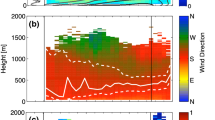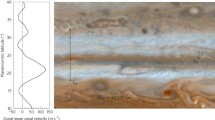Summary
An analysis of upper- and lower-tropospheric jet streaks and their associated vertical circulations prior to and during the Red River Valley severe weather outbreak of 10 April 1979 is presented utilizing the three-hourly SESAME data sets. The paper emphasizes the transformation of a transverse indirect circulation within the exit region of an upper-level jet streak (ULJ) in which the cross-contour components of the upper-level ageostrophic flow diminish in magnitude and reverse direction as the circulation's ascending branch shifts from the cyclonic-shear side to a position along the axis of the ULJ. The change in character of the vertical circulation over a 3- to 6h period appears to be related to the increasing cyclonic curvature associated with the propagation and amplification of a short-wavelength trough embedded within cyclonic flow.
A low-level jet (LLJ) forms initially within the lower branch of the indirect circulation across Texas and later intensifies, in large part, as a response to a propagating and amplifying short-wavelength trough. However, the lack of a corresponding increase of upperlevel mass divergence during this period points to the possibility also influence the low-level Montgomery streamfunction (ψm) tendencies that are a significant contributor to the forcing for the LLJ. The three-hourly data also indicate that differential advections associated with jet streak circulations and boundary layer heating can change markedly over very short periods of time and act to destabilize convectively relatively small regions immediately prior to convective outbreaks. The premise that pre-convective environments evolve over a synoptic time- and space-scale (while only the release of the convective instability occurs on the mesoscale) may, therefore, not be correct.
Zusammenfassung
Es wird eine Analyse von Jetstreaks der höheren und unteren Troposphäre und die damit verbundenen vertikalen Zirkulationen vor und während des Unwetters beim Red River Valley vom 10. April 1979 mit Hilfe der dreistündlichen SESAME-Daten vorgestellt. Die Arbeit betont die Transformation der Normalkomponente der indirekten Zirkulation im Endbereich eines Jetstreaks im oberen Niveau (ULJ). Hier verringert sich diese Komponente der ageostrophischen Strömung und kehrt ihre Richtung um, wobei der aufsteigende Ast sich von der Seite der zyklonalen Scherung auf eine Position bei der Achse des ULJ verschiebt. Diese änderung der vertikalen Zirkulation in 3 bis 6 Stunden scheint mit der vermehrten zyklonalen Krümmung, die mit dem Fortschreiten und der Verstärkung eines kurzwelligen in die zyklonale Strömung eingebetteten Troges verbunden ist, einherzugehen.
Ein Jetstream im unteren Niveau (LLJ) entsteht zuerst im unteren Ast der indirekten Zirkulation über Texas und verstärkt sich später großteils aufgrund der Veränderung des kurzwelligen Troges. Das Fehlen einer entsprechenden Massendivergenz im oberen Niveau deutet jedenfalls darauf hin, daß Prozesse in der planetaren Grenzschicht (PBL) ebenfalls die Änderungen in der Montgomery Stromfunktion (ψm) beeinflussen, die einen wichtigen Beitrag für den Antrieb des LLJ darstellen. Die dreistündlichen Daten weisen ebenfalls darauf hin, daß unterschiedliche Advektionen, die mit Jetstreak-Zirkulationen verbunden sind und die Erwärmung in der Grenzschicht sich in kurzer Zeit deutlich ändern und unmittelbar vor konvektiven Ausbrüchen relativ kleine Gebiete destabilisieren können. Daher mag die Annahme, daß sich vorkonvektive Bedingungen in einem synoptischen Zeit-und Raumscale entwickeln (während nur das Freiwerden der konvektiven Instabilität im Mesoscale auftritt) nicht richtig sein.
Similar content being viewed by others
References
Alberty RL, Burgess DW, Fujita TT (1980) Severe weather events of 10 April 1979. Bull Amer Met Soc 61: 1033–1034
Anthes RA, Kuo Y-H, Benjamin SG, Li Y-F (1982) The evolution of the mesoscale environment of severe local storms: Preliminary modeling results. Mon Wea Rev 110: 1187–1213
Beebe RG, Bates FC (1955) A mechanism for assisting in the release of convective instability. Mon Wea Rev 83: 1–10
Benjamin SG, Carlson TN (1986) Some effects of surface heating and topography on the regional severe storm environment — Part I: Three-dimensional simulations. Mon Wea Rev 114: 307–329
Benjamin SG (1986) Some effects of surface heating and topography on the regional severe storm environment — Part II: Two-dimensional idealized experiments. Mon Wea Rev 114: 330–343
Bjerknes J (1951) Extratropical cyclones. In: Malone TF (ed) Compendium of meteorology. Amer Met Soc 577–598
Blackadar AK (1957) Boundary layer wind maxima and their significance for the growth of noctumal inversions. Bull Amer Met Soc 38: 283–290
Bluestein HB, Thomas KW (1984) Diagnosis of a jet streak in the vicinity of a severe weather outbreak in the Texas panhandle. Mon Wea Rev 112: 2499–2520
Bonner WD (1966) Case study of thunderstorm activity in relation to the low-level jet. Mon Wea Rev 94: 167–178
Brill KF, Uccellini LW, Burkhart RP, Warner TT, Anthes RA (1985) Numerical simulations of a transverse indirect circulation and low-level jet in the exit region of an upper-level jet. J Atmos Sci 42: 1306–1320
Buechler DE, Fuelberg HE (1985) Budgets of divergent and rotational kinetic energy during two periods of intense convection. Mon Wea Rev (conditionally accepted)
Cahir JJ (1971) Implications of circulations in the vicinity of jet streaks at subsynoptic scales. Ph D thesis, Pennsylvania State University, p 170
Carlson TN, Ludlam FH (1968) Conditions for the occurrence of severe local storms. Tellus 20: 203–226
Carlson TN, Anthes RA, Schwartz M, Benjamin SG, Baldwin DG (1980) Analysis and prediction of severe storms environment. Bull Amer Met Soc 61: 1018–1032
Carlson TN, Benjamin SG, Forbes GS, Li Y-F (1983) Elevated mixed layers in the regional severe storm environment: Conceptual model and case studies. Mon Wea Rev 111: 1453–1473
Danielsen EF (1961) Trajectories: Isobaric, isentropic and actual. J Met 18: 479–486
Danielsen EF (1974) The relationship between severe weather, major dust storms and rapid cyclogenesis. In: Shapiro M (ed) Synoptic extratropical weather systems, NCAR, Boulder, CO, 215–241
Doswell CA, III (1982) The operational meteorology of convective weather. Vol I: Operational mesoanalysis. NOAA TM NWS NSSFC-5, II-61-III-64
Eliassen A (1962) On the vertical circulation in frontal zones. Geofys Publik 24: 147–160
Endlich RM (1961) Computation and uses of gradient winds. Mon Wea Rev 89: 187–191
Fuelberg HE (1974) Reduction and error analysis of the AVE-II pilot experiment data. NASA Contractor Report CR-12-496. Marshall Space Flight Center, AL, p 140
Fuelberg HE, Jedlovec GJ (1982) A subsynoptic-scale kinetic energy analysis of the Red River Valley tornado outbreak (AVE-SESAME I). Mon Wea Rev 110: 2005–2024
Gerhard ML, Fuelberg HE, Williams SF, Turner RE (1979) AVE-SESAME I: 25 mb sounding data. NTIS Report No NASA-TM-78256, National Technical Information Service, Springfield, VA, p 365
Hoecker WH (1963) Three southerly low-level jet systems delineated by the Weather Bureau special pibal network of 1961. Mon Wea Rev 91: 573–582
Homan JH, Vincent DC (1983) Mesoscale analysis of surface variables during the severe storm outbreak of 10–11 April 1979. Mon Wea Rev 111: 1122–1130
House DC (1961) The divergence equation as related to severe thunderstorm forecasting. Bull Amer Met Soc 12: 803–816
Kaplan ML, Zack JW, Wong VC, Tuccillo JJ (1982) Initial results from a mesoscale atmospheric simulation system and comparisons with the AVESESAME I data set. Mon Wea Rev 110, 1564–1590
Kaplan ML, Zack JW, Wong, VC, Coats GD (1984) The interactive role of subsynoptic scale jet streak and planetary boundary layer processes in organizing an isolated convective complex. Mon Wea Rev 112, 2212–2238
Ludlam FH (1963) Severe local storms: A review. Met Monogr 5/27: Amer Met Soc, 1–30
McNulty RP (1978) On upper tropospheric kinematics and severe weather occurrence. Mon Wea Rev 106: 662–672
Means LL (1952) On thunderstorm forecasting in the central United States. Mon Wea Rev 80: 165–189
Miller JE (1955) Intensification of precipitation by differential advection. J Met 12: 472–477
Moore JT, Fuelberg HE (1981) A synoptic analysis of the first AVE-SESAME '79 period. Bull Amer Met Soc 62: 1577–1590
Newton CW (1954) Frontogenesis and frontolysis as a three-dimensional process. J Met 11: 449–461
Newton CW (1959) Axial velocity streaks in the jet stream: Ageostrophic “inertial” oscillations. J Met 16: 638–645
Newton CW (1963) Dynamics of severe convective storms. Met Monogr 5/27, Amer Met Soc, 33–55
Newton CW (1967) Severe convective storms. Advances in Geophysics 12: 257–303
O'Brien JJ (1970) Alternative solutions to the classical vertical velocity problem. J Appl Met 9: 197–203
Palmén E, Newton CW (1969) Atmospheric circulation systems. Academic Press, New York, Chap 4, 5, 8, 9, and 13
Petersen RA (1986) Detailed three-dimensional isentropic analyses using an objective cross-sectional approach. Mon Wea Rev 114: 719–735
Petersen RA, Uccellini LW (1979) The computation of atmospheric isentropic trajectories using a “discrete model” approach. Mon Wea Rev 107: 566–574
Petersen RA, Uccellini LW, Mostek A, Keyser DA (1984) Delineating mid-and low-level water vapor patterns in pre-convective environments using VAS moisture channels. Mon Wea Rev 112: 2178–2198
Petterssen S (1956) Weather analysis and forecasting, vol II. McGraw-Hill, 191–195
Reiter ER (1963) Jet-stream meteorology. The University of Chicago Press, Chap 4 and 6
Sawyer JS (1956) The vertical circulation at meteorological fronts and its relation to frontogenesis. Proc Roy Soc London A 234: 346–362
Shapiro MA (1975) Simulation of upper-level frontogenesis with a 20-level isentropic coordinate primitive equation model. Mon Wea Rev 103: 591–604
Shapiro MA, Kennedy PJ (1981) Research aircraft measurements of jet stream geostrophic and ageostrophic winds. J Atmos Sci 38: 2642–2654
Uccellini LW (1976) Operational diagnostic applications of isentropic analysis. Nat Wea Digest 1: 4–12
Uccellini LW (1980) On the role of upper tropospheric jet streaks and leeside cyclogenesis in the development of low-level jets in the Great Plains. Mon Wea Rev 108: 1689–1696
Uccellini LW, Johnson DR (1979) The coupling of upper-and lower-tropospheric jet streaks and implications for the development of severe convective storms. Mon Wea Rev 107: 682–703
Uccellini LW, Petersen RA, Kocin PJ, Kaplan ML, Zack JW, Wong VC (1983) Mesoscale numerical simulations of the Presidents' Day cyclone: Impact of sensible and latent heating on the pre-cyclogenetic environment. Preprints, 6th Conf Numerical Weather Prediction. Amer Met Soc, Omaha, NE, 45–52
Uccellini LW, Kocin PJ, Petersen RA, Wash CH, Brill KF (1984) The Preisdents' Day cyclone of 18–19 February 1979: Synoptic overview and analysis of the subtropical jet streak influencing the pre-cyclogenetic period. Mon Wea Rev 112: 31–55
Whitney LF, Jr (1977) Relationship of the subtropical jet stream to severe local storms. Mon Wea Rev 105: 398–412
Williams SF, Scoggins JR, Horvath N, Hill K (1980) A preliminary look at AVE-SESAME I conducted on 10–11 April 1979. NTIS Rep No NASA-TM-78262, National Technical Information Service, Springfield, VA, p 62
Wilson GS (1982) The structure and dynamics of mesoscale systems influencing severe thunderstorm development during AVE-SESAME-I. Preprints, 12th Conf Severe Local Storms, Amer Met Soc, San Antonio, TX, 192–196
Zack JW (1981) A numerical-dynamical investigation of the role of subsynoptic inertial and isallobaric adjustments in organizing severe local storm ensembles. PH D thesis, Cornell University, p 300
Zack LW, Kaplan ML, Wong VC (1986) Numerical simulations of the subsynoptic features associated with the AVE-SESAME I case. Part I: The preconvective environment. Mon Wea Rev (conditionally accepted)
Author information
Authors and Affiliations
Additional information
With 18 Figures
Rights and permissions
About this article
Cite this article
Kocin, P.J., Uccellini, L.W. & Petersen, R.A. Rapid evolution of a jet streak circulation in a pre-convective environment. Meteorl. Atmos. Phys. 35, 103–138 (1986). https://doi.org/10.1007/BF01026169
Received:
Revised:
Issue Date:
DOI: https://doi.org/10.1007/BF01026169




